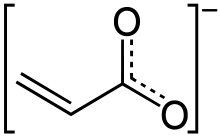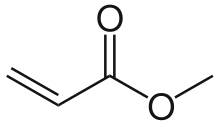Acrylate
Acrylates (IUPAC: prop-2-enoates) are the salts, esters, and conjugate bases of acrylic acid and its derivatives. The acrylate ion is the anion CH2=CHCOO−. Often acrylate refers to esters of acrylic acid, the most common member being methyl acrylate. Acrylates contain vinyl groups directly attached to the carbonyl carbon. These monomers are of interest because they are bifunctional: the vinyl group is susceptible to polymerization and the carboxylate group carries myriad functionality. Modified acrylates are also numerous, include methacrylates (CH2=C(CH3)CO2R) and cyanoacrylates (CH2=C(CN)CO2R).[1]


Use
Acrylates and methacrylates (the salts and esters of methacrylic acid) are common monomers in polymer plastics, forming the acrylate polymers. Acrylates easily form polymers. A variety of acrylate-functionalized monomers are known.[2]
Production
Acrylates are industrially prepared by treating acrylic acid with the corresponding alcohol in presence of a catalyst. The reaction with lower alcohols (methanol, ethanol) takes place at 100–120 °C with acidic heterogeneous catalysts (cation exchanger). The reaction of higher alcohols (n-butanol, 2-ethylhexanol) is catalysed with sulfuric acid in homogeneous phase. Acrylates of even higher alcohols are obtainable by transesterification of lower esters catalysed by titanium alcoholates or organic tin compounds (e.g. dibutyltin dilaurate).[3]
Appearance in nature
Acrylate has been suggested to be used by sea phytoplankton as a poisonous defense against predators such as protozoa. When attacked, DMSP lyase breaks down dimethylsulfoniopropionate (DMSP) into dimethylsulfide (DMS) and acrylate.
See also
- Acrylate polymer
- Sodium polyacrylate thickeners
- Methacrylate
References
- Takashi Ohara; Takahisa Sato; Noboru Shimizu; Günter Prescher; Helmut Schwind; Otto Weiberg; Klaus Marten; Helmut Greim (2003). "Acrylic Acid and Derivatives". Ullmann's Encyclopedia of Industrial Chemistry. Weinheim: Wiley-VCH. doi:10.1002/14356007.a01_161.pub2.
- Ervithayasuporn, Vuthichai; Chimjarn, Supansa (2013). "Synthesis and Isolation of Methacrylate- and Acrylate-Functionalized Polyhedral Oligomeric Silsesquioxanes (T8, T10, and T12) and Characterization of the Relationship between Their Chemical Structures and Physical Properties". Inorg. Chem. doi:10.1021/ic401994m.
- Arpe, Hans-Jürgen (2007). Industrielle organische Chemie: bedeutende Vor- und Zwischenprodukte (6 ed.). Weinheim: Wiley-VCH. ISBN 978-3-527-31540-6.